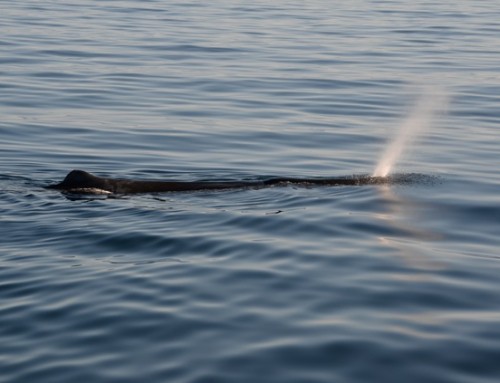For many people who participate in our Searcher Natural History Tours to Baja California, the large whales are the big attraction. It’s certainly easy to be mesmerized by the spectacular behaviors of a humpback whale, awestruck by the immensity of a blue whale, or emotionally transformed by a close encounter with a gray whale. However, despite the top-billing status of these giant creatures, they are often upstaged by the smaller species of marine mammals. Today we’ll examine one group, the dolphins, that are certainly charismatic in their own right.
All the dolphins we see in the waters around the Baja peninsula belong to the same family, Delphinidae. The family Delphinidae is comprised of about 38 species and contains the dolphin species most familiar to whale watchers. Included in the family are some species that have the word “whale” attached to their common name, such as the killer whale and the short-finned pilot whale. Some people get confused by the use of the words “whale” and “dolphin” and will ask, “Well, is the killer whale a whale or a dolphin?” In the context of the family Delphinidae, the word “whale” attached to the common name simply indicates a larger species of delphinid.
Fourteen species of delphinids have been documented in Baja. Some species, such as the bottlenose dolphin and the long-beaked common dolphin, are observed on almost every Searcher trip. Other species, however, are much less common. For example, the first scientific record of the pygmy killer whale in the Gulf of California (Sea of Cortez) was from October 2014 in La Paz Bay. In eleven years of trips to Baja aboard Searcher, I’ve seen eight of the fourteen species. These eight species are discussed in approximate order from most-likely-to-be-seen to least-likely-to-be-seen, focusing on identification characteristics.
Long-beaked common dolphin: This is by far the most common species of cetacean associated with Baja. We see them from the Searcher on both the ocean and gulf sides of the peninsula. Long-beaked common dolphins are known for occurring in huge herds, often numbering in the hundreds of individuals, and sometimes in the thousands. However, we also often encounter much smaller groups. These dolphins are typically 6.5 – 8 feet long (2 – 2.5 m). They have a characteristic “hourglass” color pattern on their body that becomes more pronounced in older individuals. Closely related to the short-beaked common dolphin, long-beaked common dolphins can be distinguished by their relatively longer rostrum (along with some very subtle color differences). It can be challenging at times to separate the two species in the field, especially because younger individuals of both species can look quite similar to each other both in terms of coloration and rostrum length.
Bottlenose dolphin: These dolphins are found throughout the Baja California region, both on the ocean side and in the Gulf of California. We see them on a regular basis in Laguna San Ignacio, where they are the only species of dolphin represented. Bottlenose dolphins can get large, with adult lengths ranging from just over six feet to almost 12 feet (1.9 – 3.6 m). They are mostly uniform gray in color, with some slight color variations. Their rostrum (beak) is stocky and short to moderate in length. These dolphins often engage in acrobatic behavior, making them favorites among whale watchers.
Short-beaked common dolphin: In general, the distribution of the short-beaked common dolphin in Baja overlaps that of the long-beaked common dolphin. However, the short-beaked species tends to be found in deeper water, and is not as abundant or widely distributed in the Gulf of California as the long-beaked species. There are some subtle color differences between the two species, but I think in most cases the relative length of the rostrum is the more dependable characteristic. Even then, distinguishing between the two rostrum lengths (especially with younger dolphins) takes some practice and experience.
Risso’s dolphin: We’ve seen Risso’s dolphins both in the Gulf of California and on the Pacific side of the peninsula, although they are more likely to be found on the Pacific side. Risso’s dolphins can get up to 12 feet (3.6 m) long. They are characterized by such morphological features as a tall slender dorsal fin, a lack of a rostrum, and a crease in the melon. Probably the most distinctive feature is the amount of scarring on the body. Whereas young animals have a uniform gray color, older animals are typified by increasing numbers of scars and a resultant lightening of the overall body color. These scars are most likely the result of encounters with their squid prey and/or rake marks from other Risso’s dolphins.
Short-finned pilot whale: This is one of the larger members of the family Delphinidae, with females reaching 18 feet (5.5 m) and males 23 feet (7 m). Identification characteristics include a black to dark-gray body color, no rostrum, a prominent bulbous melon, and a dorsal fin with a very broad base. Pilot whales are highly social and live in tight-knit family groups.
Pacific white-sided dolphin: Although there are records of Pacific white-sided dolphins occurring along the entire Pacific coast of the Baja peninsula, and into the gulf as well, in my experience we usually encounter them only along the northern half of the Pacific side. By the time we get south of Laguna San Ignacio, we rarely see this species. Pacific white-sided dolphins get up to 8 feet (2.4 m) in length. They are characterized by a very small rostrum, a complex white-gray-black body coloration pattern, and a prominent recurved dorsal fin (mostly light colored with a dark leading edge).
Killer whale: The killer whale is the largest member of the family Delphinidae, with males reaching 32 feet in length (9.7 m); females are about a meter shorter than males. In addition to their large size, their dramatic black and white color pattern makes them instantly recognizable. The underside of the whale is white, with a lobe of white extending onto the flank. There is also a white oval patch near the eye and a gray “saddle” behind the dorsal fin. The pectoral flippers are large and paddle-shaped. The dorsal fin is quite tall and straight in males. As with all apex predators, the numbers of killer whales are always much fewer than animals lower in the food web, which helps explain why we rarely see them on our Baja trips.
False killer whale: The false killer whale is another large species of delphinid, with males reaching lengths of almost 20 feet (6 m) and females 16 feet (5 m). They have a slender body, no beak, a melon that overhangs the mouth, and pectoral flippers with a distinctive S-shape. They are black to dark gray in color, with some areas of lighter gray.
Others: The following delphinid species are rarely seen in Baja, but there are some records of their occurrence: rough-toothed dolphin, pantropical spotted dolphin, spinner dolphin, striped dolphin, melon-headed whale, and pygmy killer whale. In 2016 the Searcher encountered a few dolphins that may have been rough-toothed dolphins.




